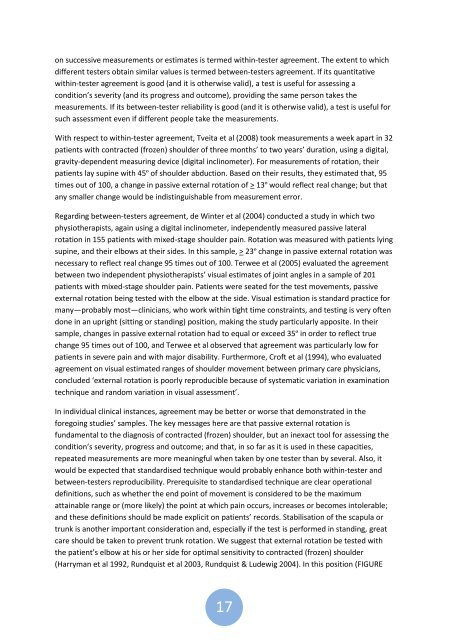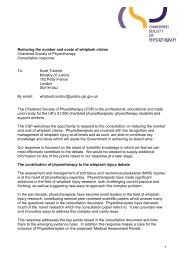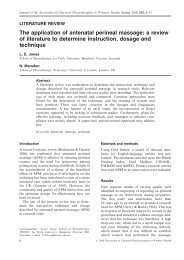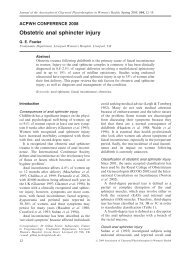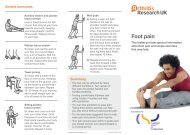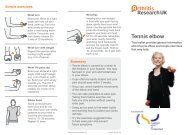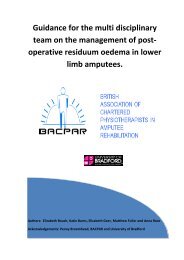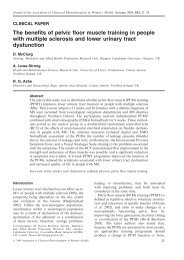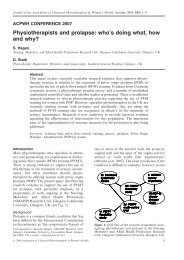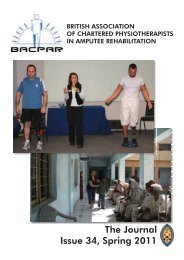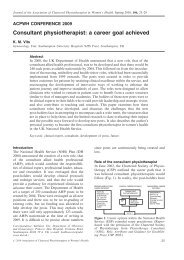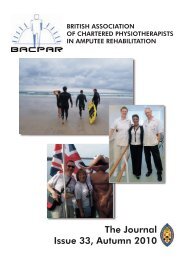here - The Chartered Society of Physiotherapy
here - The Chartered Society of Physiotherapy
here - The Chartered Society of Physiotherapy
You also want an ePaper? Increase the reach of your titles
YUMPU automatically turns print PDFs into web optimized ePapers that Google loves.
on successive measurements or estimates is termed within-tester agreement. <strong>The</strong> extent to which<br />
different testers obtain similar values is termed between-testers agreement. If its quantitative<br />
within-tester agreement is good (and it is otherwise valid), a test is useful for assessing a<br />
condition’s severity (and its progress and outcome), providing the same person takes the<br />
measurements. If its between-tester reliability is good (and it is otherwise valid), a test is useful for<br />
such assessment even if different people take the measurements.<br />
With respect to within-tester agreement, Tveita et al (2008) took measurements a week apart in 32<br />
patients with contracted (frozen) shoulder <strong>of</strong> three months’ to two years’ duration, using a digital,<br />
gravity-dependent measuring device (digital inclinometer). For measurements <strong>of</strong> rotation, their<br />
patients lay supine with 45º <strong>of</strong> shoulder abduction. Based on their results, they estimated that, 95<br />
times out <strong>of</strong> 100, a change in passive external rotation <strong>of</strong> > 13º would reflect real change; but that<br />
any smaller change would be indistinguishable from measurement error.<br />
Regarding between-testers agreement, de Winter et al (2004) conducted a study in which two<br />
physiotherapists, again using a digital inclinometer, independently measured passive lateral<br />
rotation in 155 patients with mixed-stage shoulder pain. Rotation was measured with patients lying<br />
supine, and their elbows at their sides. In this sample, > 23º change in passive external rotation was<br />
necessary to reflect real change 95 times out <strong>of</strong> 100. Terwee et al (2005) evaluated the agreement<br />
between two independent physiotherapists’ visual estimates <strong>of</strong> joint angles in a sample <strong>of</strong> 201<br />
patients with mixed-stage shoulder pain. Patients were seated for the test movements, passive<br />
external rotation being tested with the elbow at the side. Visual estimation is standard practice for<br />
many—probably most—clinicians, who work within tight time constraints, and testing is very <strong>of</strong>ten<br />
done in an upright (sitting or standing) position, making the study particularly apposite. In their<br />
sample, changes in passive external rotation had to equal or exceed 35º in order to reflect true<br />
change 95 times out <strong>of</strong> 100, and Terwee et al observed that agreement was particularly low for<br />
patients in severe pain and with major disability. Furthermore, Cr<strong>of</strong>t et al (1994), who evaluated<br />
agreement on visual estimated ranges <strong>of</strong> shoulder movement between primary care physicians,<br />
concluded ‘external rotation is poorly reproducible because <strong>of</strong> systematic variation in examination<br />
technique and random variation in visual assessment’.<br />
In individual clinical instances, agreement may be better or worse that demonstrated in the<br />
foregoing studies’ samples. <strong>The</strong> key messages <strong>here</strong> are that passive external rotation is<br />
fundamental to the diagnosis <strong>of</strong> contracted (frozen) shoulder, but an inexact tool for assessing the<br />
condition’s severity, progress and outcome; and that, in so far as it is used in these capacities,<br />
repeated measurements are more meaningful when taken by one tester than by several. Also, it<br />
would be expected that standardised technique would probably enhance both within-tester and<br />
between-testers reproducibility. Prerequisite to standardised technique are clear operational<br />
definitions, such as whether the end point <strong>of</strong> movement is considered to be the maximum<br />
attainable range or (more likely) the point at which pain occurs, increases or becomes intolerable;<br />
and these definitions should be made explicit on patients’ records. Stabilisation <strong>of</strong> the scapula or<br />
trunk is another important consideration and, especially if the test is performed in standing, great<br />
care should be taken to prevent trunk rotation. We suggest that external rotation be tested with<br />
the patient’s elbow at his or her side for optimal sensitivity to contracted (frozen) shoulder<br />
(Harryman et al 1992, Rundquist et al 2003, Rundquist & Ludewig 2004). In this position (FIGURE<br />
17


